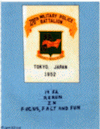At the start of the year LTC Alvin B. Welch was commanding. The 720th Military Police Battalion and its organic units, HQ&HQ Detachment, HQ Company, Able, Baker and Dog Companies were located in Camp Burness at Z Avenue and 20th Street Tokyo, Occupied Japan subordinate to Headquarters & Service Group, General Headquarters (GHQ), Far East Command under the operational control of the Provost Marshal, Tokyo Metropolitan Area
Sometime during the year the battalion also began publishing a biweekly Newsletter called “The Sumida Sentinel.” The staff consisted of one officer as the Editor, one senior NCO as the Assistant Editor, a junior enlisted man as the typist, and a junior NCO was the Art Editor. The Publication Editor was a civilian.
The Armed Forces Press Service provided much of the material used. Each company was allotted a separate section similar to a community news column in a small town newspaper.
The only know copy still in existence was published on 30 June 1953.
The cantonment facilities at Camp Burness provided an opportunity for a well-balanced and orderly life. They included a service club, library, snack bar, hobby shop, post exchange, barber shop, pressing shop, gymnasium, pistol range (installed during the year), officers and enlisted men's open messes, theater, outdoor athletic courts, company day rooms, motor pool, bachelor officers quarters, and many other conveniences.
Each member of the battalion was issued HQ Far East Command Bulletin No. 2, “Traffic Laws”, prepared and printed by the Troop Information and Education Section, Tokyo.
High standards of moral principals were maintained in all units, with emphasis being given to the development of individual character. The high percentage of voluntary attendance at church services and the gentlemanly and sportsmanlike attitudes displayed in operational, athletic and other endeavors attested to the high caliber of individuals who were assigned to the organization.
There were also many military service clubs available to those that were looking for a quieter nightlife than that found off base.
By 1952 the city of Tokyo was also an entertainment mecca, and the draw of the many “On Limits” Japanese nightclubs, bars and hotel bars in and around the Ginza area that catered to the troops and tourists provided meals, drinks, live entertainment, dancing and female companionship for the thousands of U.S. and Allied military personnel stationed within the country, as well as those visiting for Rest & Relaxation (R&R) leave from Korea.
















 PFC Snowden
PFC Snowden CPL Bjorlin
CPL Bjorlin SGT Patton
SGT Patton Alfred R. Sirven
Alfred R. Sirven Edmond Parriel
Edmond Parriel PFC Craig
PFC Craig

 CPLs Pensergast & Fahey
CPLs Pensergast & Fahey














 CPL St. Pierre
CPL St. Pierre CPL Dimarco
CPL Dimarco PFC Womack
PFC Womack SGT Wood
SGT Wood





 Eisenhower
Eisenhower Nixon
Nixon Stevenson
Stevenson Sparkman
Sparkman

 LTC Welsch
LTC Welsch PFC Cook
PFC Cook